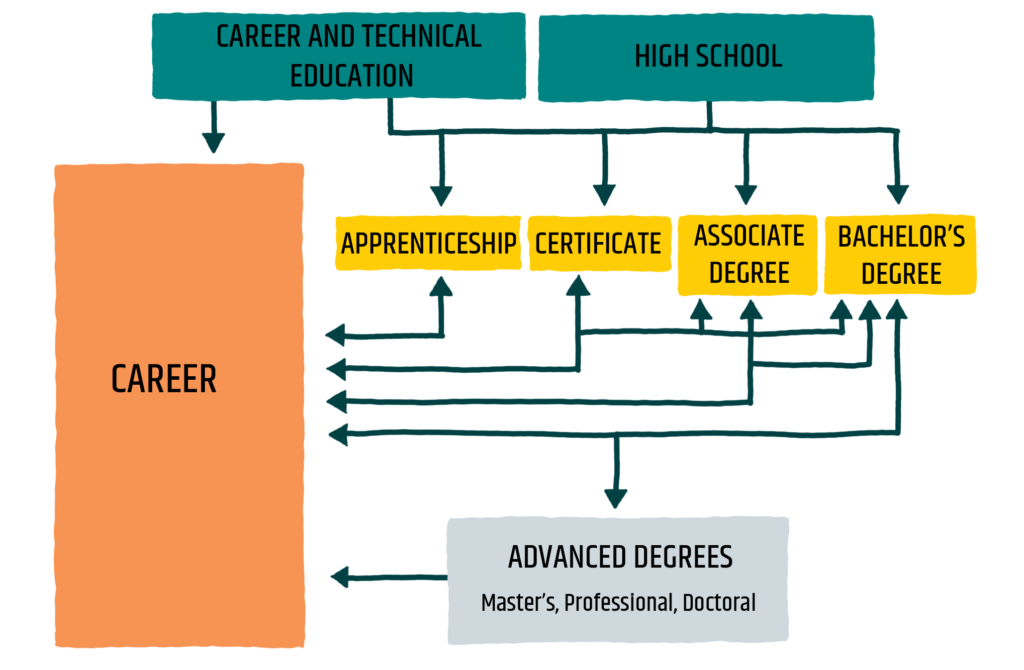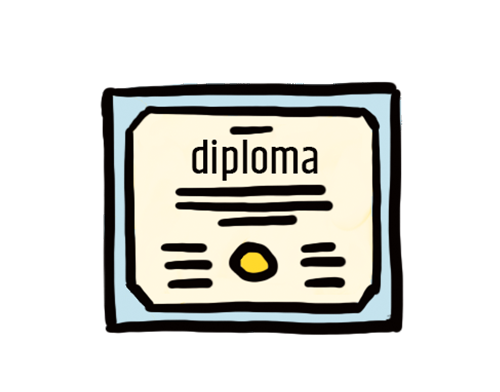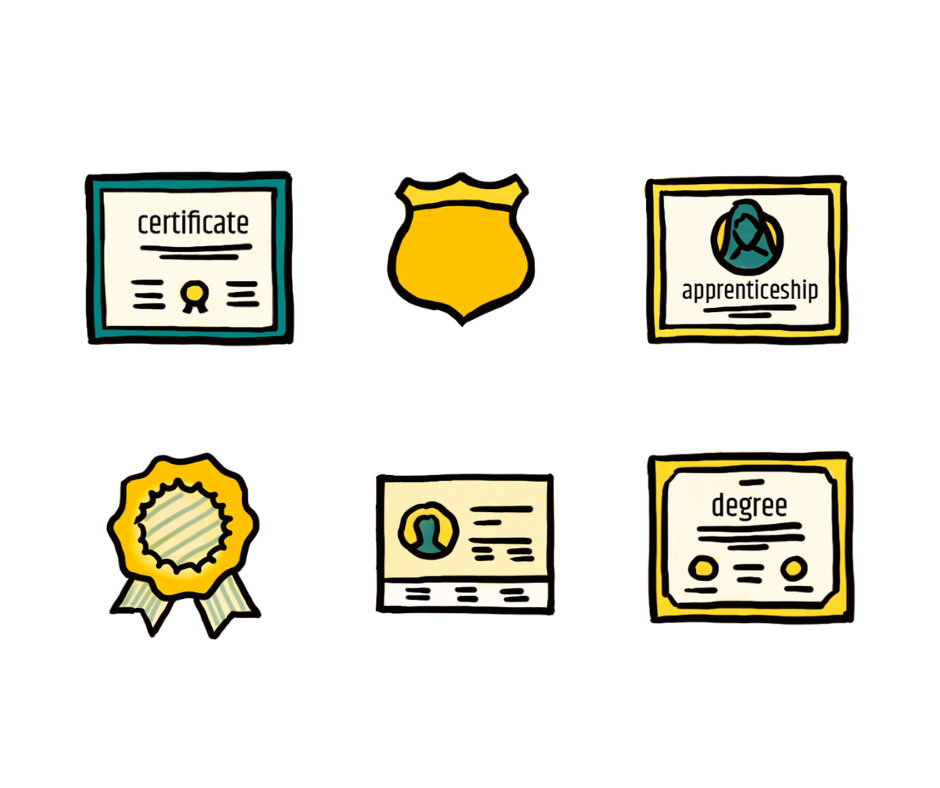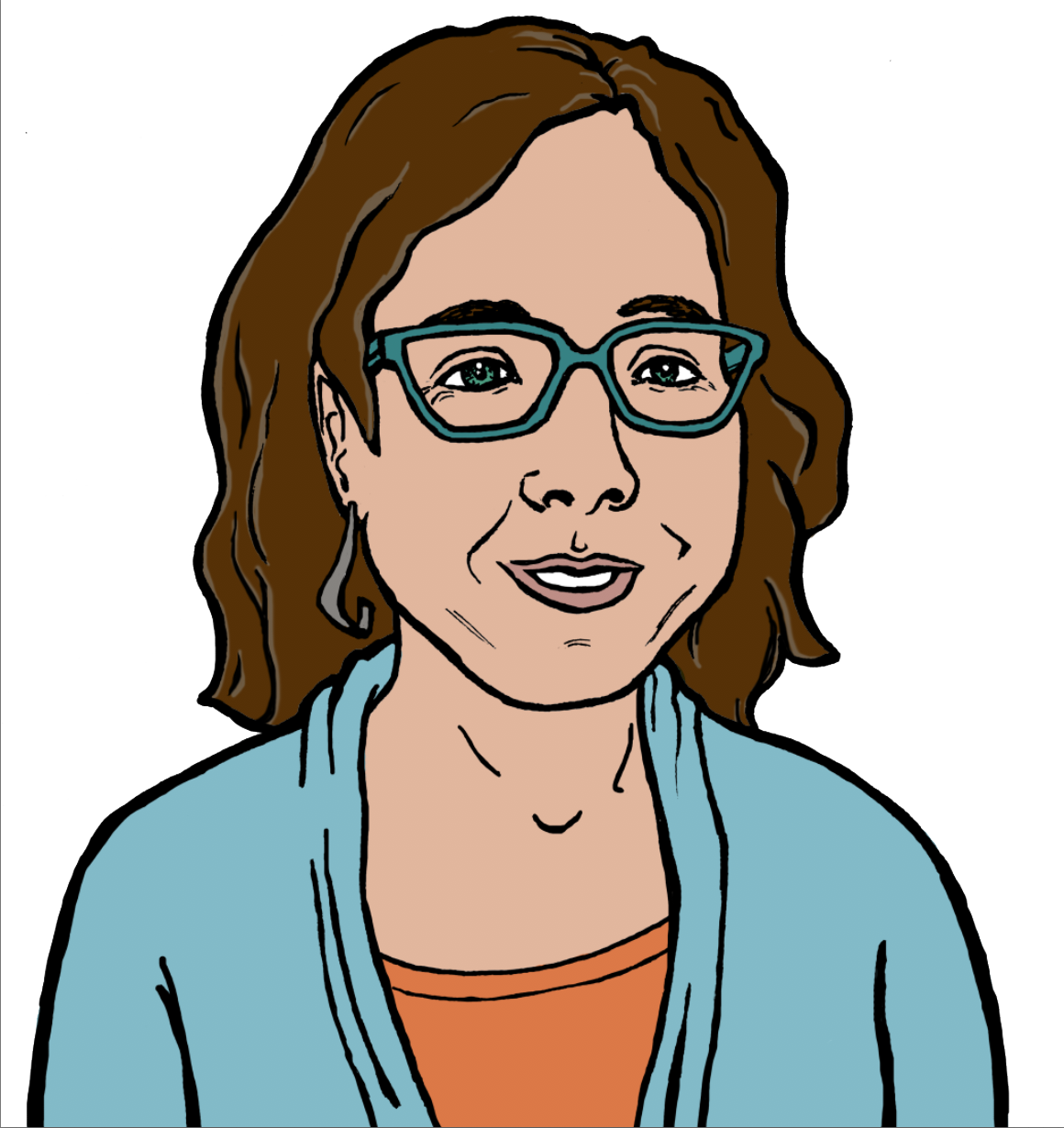JUMP TO: Why Education and Training | Pathways for High Schoolers | Finish High School or GED | Pathways After High School
From apprenticeships to degree programs and on-the-job training to certificate programs, there’s bound to be an education or training program that works for you and gets you one step closer to your goals.

Why Education and Training?
- More job opportunities. Education and training is the best way to build out your skills and increase your chances at being hired. This means more fulfilling job and career options.
- Money, money, money. Vermonters with education and training after high school make thousands more dollars a year, and your salary will grow with your level of training.
- Invest in yourself. So many of us have dreams, or goals, or plans that ignite joy and pride. Chase after them, no matter how big or small.
Flexible Pathways for High Schoolers
High schoolers: you have the ability to make high school what you want it to be. Save time and money by getting a jump start on your college credits or career experience before you’ve even graduated high school!
High school students in their junior and senior year can enroll at one of the 15 regional career and technical centers to enter a Career and Technical Education (CTE) program. CTE programs offer a chance for you to learn hands-on skills for a career or post-high school training program. Programs may last a for part of the school day or all of the school day, and they will be a combination of academic and technical instruction. You will learn career skills while completing your high school diploma. 9th or 10th graders interested in technical education might be able to try the Pre-tech Exploratory and Foundational programs
Cost: Free
See if you are eligible for a CTE program, or talk to your school counselor about how to apply.
As a dual enrollment student you can take up to two free college courses during your junior and senior years of high school. The courses can count for college credit and high school credit. Even though you’re taking college courses, you’d still be enrolled at your high school and have a typical class schedule. Classes may be at a local college campus, online, or taught at your high school. You can meet with an advisor from the college or university you want to attend and select a class that fits your Personalized Learning Plan and meets your college and career goals. To access your free courses, you can work with your school counselor to apply for the dual enrollment voucher through the Vermont Agency of Education. Once your voucher is approved, you can sign up for the course – tuition free. VSAC also offers a stipend to help pay for textbooks if you receive Free and Reduced Lunch.
Cost: Free (with voucher)
Learn more about Dual Enrollment or talk to your school counselor about it.
Fast Forward allows students who are enrolled in certain Career and Technical Education (CTE) programs to take college classes, taught by the Technical Center teacher during the school day. This means you can work toward completing your technical center program requirements while also getting a head start on college. Work with a school counselor or Technical Center teacher to apply for a Fast Forward ticket. Talk with an advisor at CCV or VTC to complete the steps for enrolling in your Fast Forward courses for free.
Cost: Free (with Fast Forward ticket)
Learn more about Fast Forward or talk to your school counselor or a CTE instructor about it.
Vermont high school seniors pursuing Early College spend their final year in high school as a full-time college student. This means that you no longer attend classes at your local high school and instead go to classes on a college campus or online. After finishing your full-time fall and spring semester courses, you graduate high school with all your friends and have a year of college credits under your belt.
Students especially interested in science and technology can explore the Vermont Academy of Science and Technology (VAST) Early College program through Vermont Technical College.
VSAC also offers a stipend to help pay for textbooks if you receive free and reduced lunch.
Cost: Free
For Vermont’s high school classes of 2023-2026, the McClure Foundation is offering the McClure Free Degree Promise through the Early College Program at CCV — which builds on the Early College program at the Community College of Vermont (CCV) to give students who continue the chance to earn a free associate degree of their choosing the year after high school graduation.
Learn more about Early College or talk to your school counselor about it.
High school students can learn outside of the classroom to help relate your schoolwork with the real world. Connect with people in your community to learn more about their industry, career, role, or work environment. This type of exposure can help you build your skills, see what different jobs are like, and get a sense of what type of training you might need after high school. The goal of these in-person or virtual opportunities is to help expose you to different education and career opportunities.
Cost: Free
Learn more about Work Based Learning or talk to your school counselor about it.
Finish High School or Earn Your GED

Not everyone graduates from high school, and we get that. There are a number of free or affordable programs that can help you earn your GED or high school diploma, if you’re older than 16. A high school diploma or GED will give you access to better paying jobs and allow you to continue your education and training. A high school diploma or GED may be your first credential, but in some ways, it is your most important.
Completing your high school diploma: If you are eligible for Vermont High School Completion Program, you will start working with an Adult Education and Literacy (AEL) provider. They will work to understand what skills and knowledge you already have. From there, you will develop a Personalized Learning Plan to map out the best way for you to meet each school’s graduation expectations you need to earn your high school diploma. You can meet your learning goals through a variety of ways: classes with an AEL provider, at a local high school, Technical Education classes, college courses, or other work-based learning experiences. When you are finished, you will walk away with a high school diploma in your hand.
Cost: Free
Get in touch with your local adult basic education provider to take the next step toward your high school diploma.
Education and Training Pathways After High School

The good news is that you have access to many different types of education and training. Once you have a high school diploma or GED in hand, you can explore your options and see which education and training pathway is a good fit for you.
Credentials can be earned through technical centers, colleges, universities, training centers, and even through online programs. If you are a high school student or adult looking to technical education to earn certification or licensure, consider the regional technical center near you. Vermont’s colleges and universities offer certificates and 2-year, 4-year, and graduate degrees. Check out a list of those institutions here.
A certificate is a great way to show employers you have a strong foundation to start in a new career or industry. Or a certificate can show that you have knowledge about a specific subject in an industry you already work in that makes you an extra valuable employee. You don’t have to take general education courses, which means your training will be totally focused on the skills you need. This makes it shorter and more affordable. The experience you gain in a certificate program can help you earn a degree or other credential faster if you decide to continue your training.
Offered by: Colleges, universities, and technical centers
Length of time: A few months – 2 years
Learning environment: Traditional classroom, hands-on learning, and/or a job site
General Education Requirement (English, Math, Social Studies): No
Online Options: Yes
Average total cost before financial aid: $2,000-$25,000. (Remember: financial aid can make this price much, much lower.)
Explore certificate programs in Vermont.
Registered Apprenticeships prepare people for a career through on-the-job training plus related classroom instruction. You will be paid for the work you do while being trained on the job. Many people begin their apprenticeships with little or no experience in that career. Apprentices start as entry level workers who learn on the job from someone who has worked in their field for many years. Your employer will make sure you have all the skills necessary to become licensed in your profession when your apprenticeship is finished. Apprenticeships are available in many different careers and industries.
Offered by: Businesses, colleges, other organizations
Length of time: 1-2 years
Learning environment: Mostly on-the-job, some time in traditional classrooms
General Education Requirement (English, Math, Social Studies): No
Online Options: No
Average total cost before financial aid: Free (and don’t forget, you get paid while enrolled!)
Explore the Registered Apprenticeships in Vermont.
Get a degree that focuses on building skills and knowledge for a specific job or career. Many Associate degree programs can be flexible, making it easier to continue to work, raise kids, or meet other life demands while earning a degree. Full time students take 4-5 classes per semester in order to graduate in 2 years, and most of these classes will focus on your area of study. Associate degrees cost less than a Bachelor’s degree because you spend fewer hours in class. An Associate degree shows an employer that you have the foundation to launch a career and build on your experience. It also shows a 4-year college that you are ready to take on a Bachelor’s degree if you choose to continue your education.
Offered by: Colleges and universities
Length of time: 2-4 years
Learning environment: Mostly traditional classroom, some hands-on learning, and/or a job site
General Education Requirement (English, Math, Social Studies): Yes
Online Options: Yes
Average total cost before financial aid: $15,000-$50,000. (Remember: financial aid can make this price much, much lower.)
Explore the Associate Degree programs in Vermont.
A bachelor’s degree sets a student up with academic and career opportunities, prepares them for a wide range of jobs, and can lead to more advanced degrees. Students take 4-5 classes a semester to graduate in 4 years. These classes will be a combination of general education courses and classes specific to your area of study. The variety of courses will build your knowledge and experience in multiple areas to help prepare you for a career. A bachelor’s degree shows an employer that you have a wide range of skills. Plus, college student groups, internships, and networks can connect you to people, places, and opportunities that can help you meet your goals.
Offered by: Colleges and universities
Length of time: 4-6 years
Learning environment: Mostly traditional classroom, some hands-on learning, and/or a job site
General Education Requirement (English, Math, Social Studies): Yes
Online Options: Yes
Average total cost before financial aid: $100,000 (Remember: financial aid can make this price much, much lower.)
Explore the Bachelor’s Degree programs in Vermont.
Navigator Toolkit
Check out this navigator toolkit if you are helping someone in your life make decisions about their education and training journey. Whether you are a parent, school counselor or teacher, coach, or community member, it is important that navigators are well-equipped with the resources necessary to promote supportive and ongoing conversation about the importance of education and training after high school.
